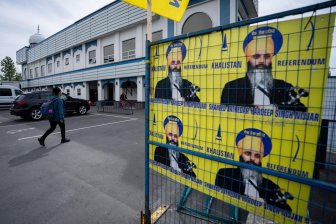It’s hard for people who lived through the 2003 Okanagan Mountain Park Fire to overstate how much things changed in its wake.

“This fire is obviously the worse thing that we have ever seen in this city and probably the worst thing we ever will see,” Gerry Zimmermann, the man in charge of the Kelowna Fire Department Aug. 16, 2003,said at the time.
Twenty years later, the statement holds true.

Until this year’s Donnie Creek fire, it was B.C.’s largest interface fire on record, and some have argued it’s changed everything from how this city was seen on a world stage to the way future fires were dealt with.
Started with a lightning strike, the fire grew to approximately 250 square kilometres, which is just about double the size of the City of Vancouver. It displaced 33,00 people who were ordered to flee their homes and caused millions of dollars of damage.
“The first night we lost houses … we lost 15 in the Rimock Timberline area, you know, and that was huge because most of us had only seen two houses go up at one time. So 15 was massive,” said Zimmermann this week, reflecting on the catastrophe.
Those numbers paled in comparison to the number of homes that the firestorm would consume the next night, as the fire grew into a 100-metre wall of flame, it roared across the south slopes of Kelowna’s Mission neighbourhood and beyond.

“That’s when it hit up in around (the) Crawford area and that night we lost 224 homes,” Zimmermann said. In total, 239 homes were lost.
In archive footage of the firefight, Zimmermann laid bare all that he and other firefighters were struggling with as they worked to save homes.
Firefighters had become trapped and cut off by an advancing wall of flame.
“We couldn’t get them out. They were trapped up in the Kettle Valley, so they went to a big open area and hunkered down under their trucks. We thought we had lost them at that point,” he said.
One of the survivors of that ordeal told reporters at the time that he, and many others, feared they were going to die as the fire raged on.
And, at least three firefighters lost their own homes that night as they fought to protect the homes of others.

Zimmermann said there was a plan in place to bulldoze homes to ground for a fireguard to save the rest of the city — if that’s what it came to.
It didn’t, and, weeks later, the fire died out on its own in mid-September, leaving carnage and something a little more hopeful in its wake.
In some ways it’s not what was lost that left an impression on Zimmermann.
It was, he said, this city’s “finest hour” as men and women worked tirelessly to alleviate the pain so many of their neighbours were experiencing.
Former Mayor Water Gray, who was also front and centre during the devastation, has a similar take, remembering that time not only for what was lost but also for what it inspired.
“We became a community, we cared about our neighbours and if there’s a positive side to the fire it’s that it brought Kelowna together as a tightly knit community,” Gray said.
- Suspect in killing of temple leader Hardeep Singh Nijjar got student visa in ‘days’
- Panera to remove ‘Charged Sips’ drink from Canada amid wrongful death lawsuits
- ‘Summer of discontent’ coming over public service in-office order: unions
- AstraZeneca says it’s withdrawing COVID vaccine amid low demand



Comments